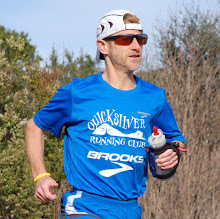While in Saint Louis, I did run through various neighborhoods, starting from Hydrobase where we were staying (the part of the lagoon Mermoz was used to make a stop with his hydroplane between Europe and South America). The road was going through the most populous part of the city, the Fishermen Quarters, and I never saw so many young kids at once. Actually, I was happy to run rather than walk through this crowd, I think running is the best way to visit Senegal, if you can accommodate the overwhelming heat, as locals won't bother running after you. I meticulously followed the suggested tour map of my guide book (from Lonely Planet), stopping at many picture opportunities yet passing a few calèches, the local horse cart for tourists. I must say that the city needs a lot of restoration to make it appealing, nothing like Dubrovnik which is a pearl despite the recent war.
Then I ventured further East, across the long Faidherbe Bridge, into other populous neighborhood "shining" by the garbage all over the place. I'm sorry to have to say that, but, with the amazing sense of hospitality of the Senegalese as well as hundreds of miles of sandy beaches on the Ocean, Senegal owes to take the environment more seriously to make the country more appealing to tourists.
We saw mostly pelicans at the Djoudj park, similar to those I see in the Bay Area when running at Alviso or Shoreline, but thousands times more! Most of the other birds will only migrate down to Djoudj later this winter.
While the rest of the group was touring the city on the Calèche, on the circuit I had done in the morning,
I spent some time with one of the coders who lives in Saint Louis, Ousmane.
Back to Dakar, we met the Coders again on Monday evening after spending the day finalizing our report, tools and recommendations. Tuesday was marked by our conference at UCAD the largest university in Dakar with 80,000 students (!) and 6,000 staff. Professor Alex Corenthin got us an amazing asset, allowing us to use the huge amphitheater of UCAD 2, with 1,200 seats. Unfortunately, and despite the efforts of Léger and I to visit schools on Monday afternoon and Tuesday morning to "recruit" participants to this free conference, less than 50 participants showed up. Very unfortunate as it turned out to be a great content put up by 10 of our group. That was yet another manifestation of the famous "Insha'Allah" (Inch'Allah in French) which I initially interpreted as a polite salutation when I arrived in Senegal, but is really a way to avoid commitment and let God decide for you. I saw more than 100 students at IAM (Institut Africain de Management), many of them telling me "We will come" before adding... "Insha'Allah" and God had indeed other plans for them apparently. I hope the next CSC team in Senegal is more successful with that critical part of our project.
To add to the Public Relations fiasco, IBM Africa decided not to conduct a press conference, as opposed to last year's team in Thies, we missed a major opportunity to get the IBM name out of the shadow it is today. Microsoft of course, but also Google, are quite famous here, too bad we couldn't get the word out beyond the mere press release.
On Wednesday, the US citizens of our group met with US Ambassador Lukens, thanks to my son's (Alex) connections at the Department of State. We enjoyed learning about the role and activity of the Ambassador, in particular the challenge of coordinating hundreds of employees working on many project to support Senegal. I invited Amadou Daffé, Co-Founder and CEO of Coders4Africa who had just landed on Wednesday morning, coming all the way from New Jersey to meet us and discuss the findings of our engagement on Thursday (Amadou on the left of the group, below, as we are all "tied up" for the final presentation at ITA).
On Friday, we had the final presentation to our 4 clients, at ITA where we had the kick-off 4 weeks ago. It was great to hear about the work of other teams and see opportunities for connecting our clients, such as H&C and Coders4Africa around the use of SME Toolkit, or Coders4Africa and DAPSA and ITA for some IT services. 4 weeks already, what an amazing experience and opportunity to learn about a different culture and focus on sustainable development for the present and future generations of Senegalese!
And more pictures of course... Here are the expanded list of direct links:
- Beach cleaning (Sunday October 13)
- Team building (Sunday October 13)
- Kick-off @ ITA (Monday October 14)
- Tabaski (Wednesday October 16)
- All-hands with Coders4Africa (Friday October 18)
- Ile de Gorée (Saturday October 19)
- Safari @ Bandia (Sunday October 20)
- Western Corniche run (Sunday October 20)
- Metings with Coders4Africa at iDEV (Monday-Friday October 21-25)
- Saly (Saturday October 26) (I actually need to upload pictures from my BlackBerry)
- Pink Lake (Sunday October 27)
- Sup'Imax SMEToolkit presentation (Wednesday October 30) See also the great pictures from Mr. Didier Diop, Director of Sup'Info Group, on Facebok.
- Djoudj bird national reserve (Saturday November 2)
- Saint Louis (Sunday November 3)
- Back to Dakar
- Running tour of Dakar (Friday November 8)
I'll write one more post as a conclusion of our great Senegalese experience, after the dust of my unpacking in California settles...
#ibmcsc senegal













.jpg )

No comments:
Post a Comment